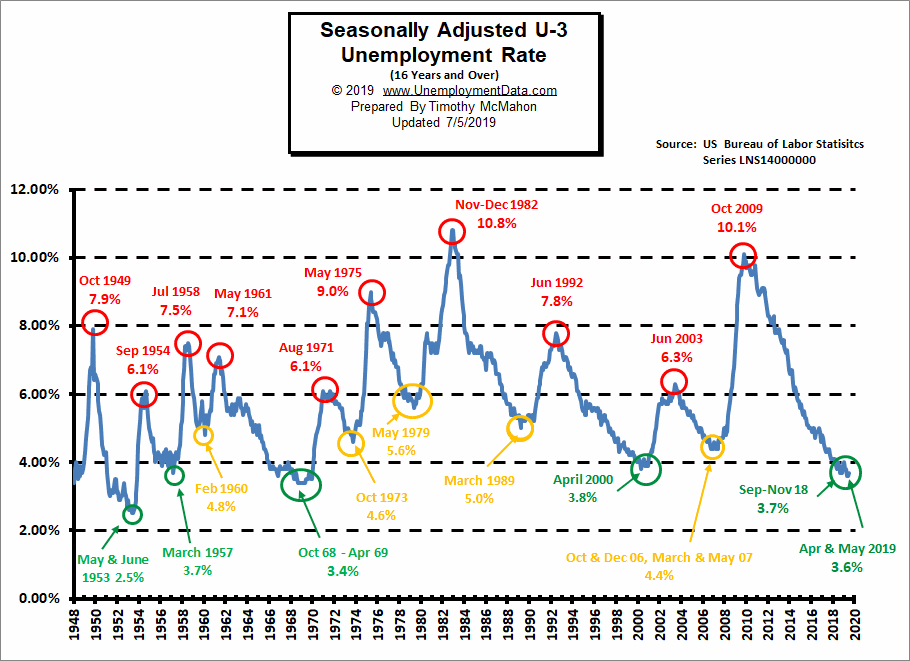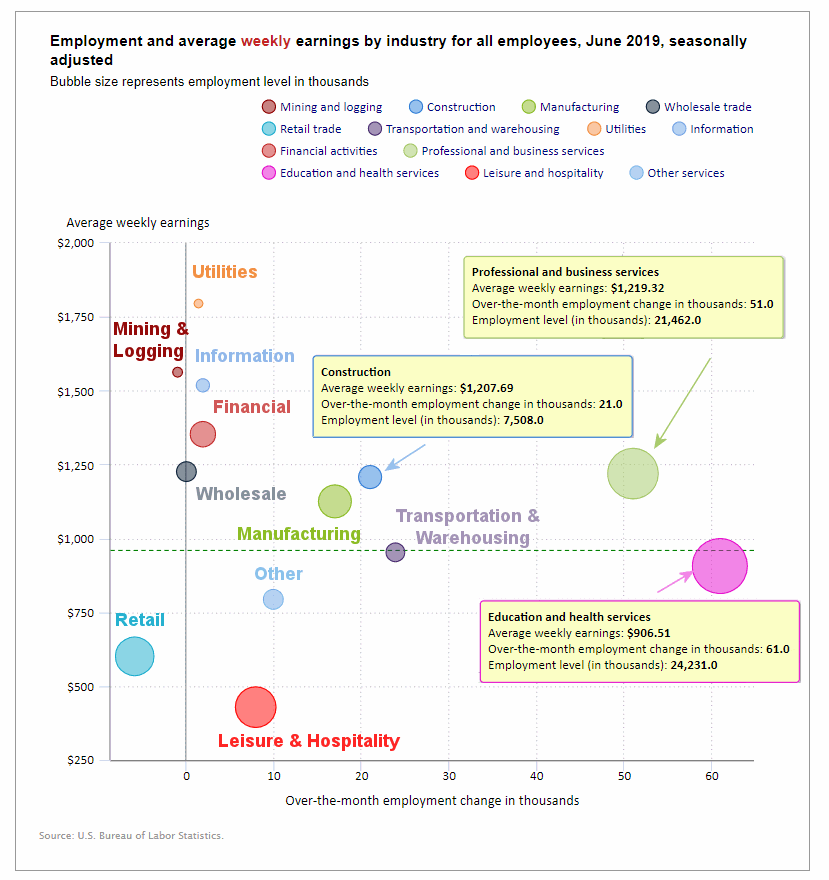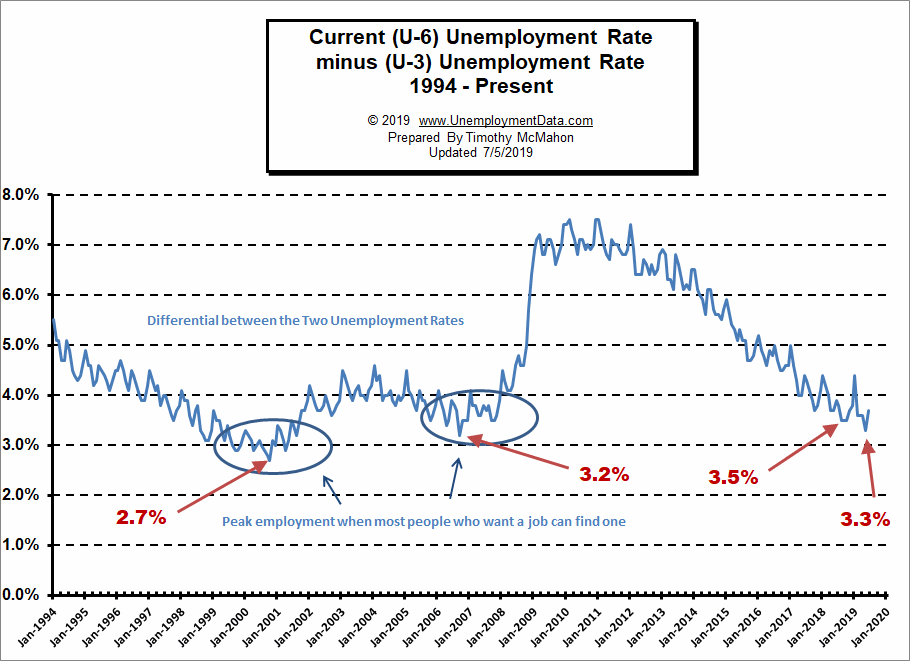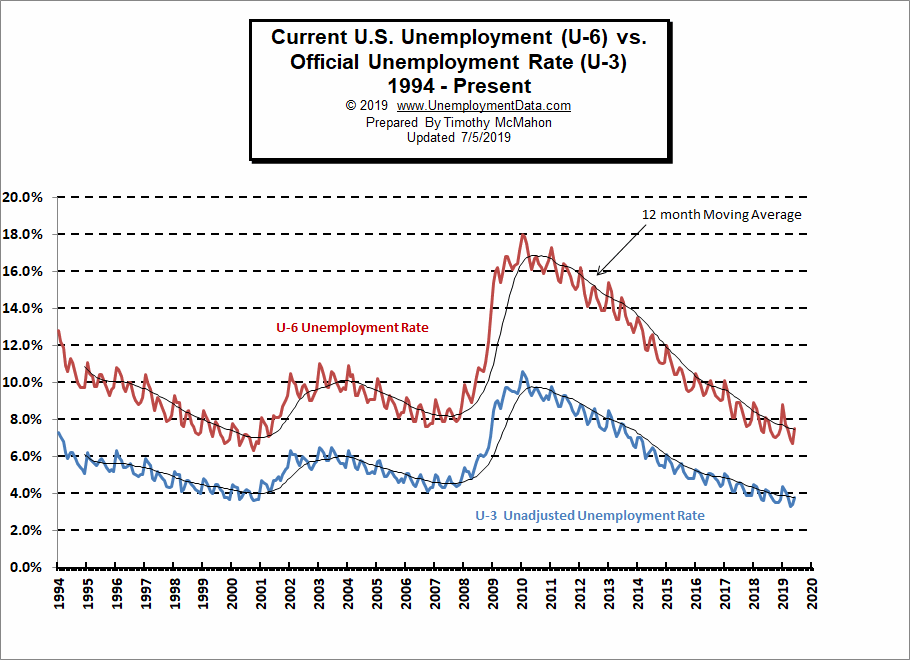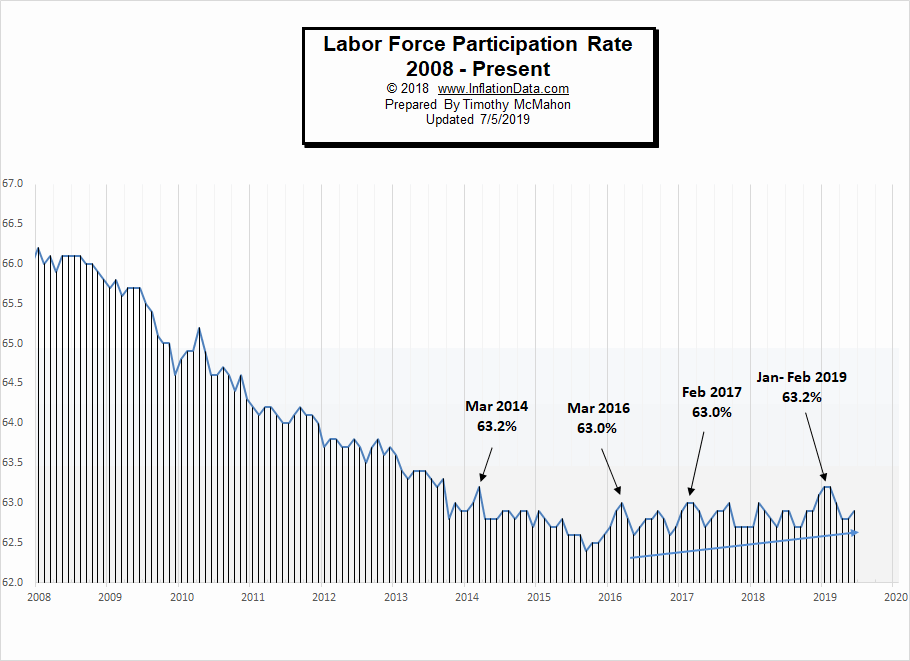![]() The U.S. Bureau of Labor Statistics (BLS) released their monthly unemployment survey results for June on July 5th. Unemployment is still near record lows but it has ticked up a bit.
The U.S. Bureau of Labor Statistics (BLS) released their monthly unemployment survey results for June on July 5th. Unemployment is still near record lows but it has ticked up a bit.
According to the Commissioner of the U.S. Bureau of Labor Statistics:
” Nonfarm payroll employment increased by 224,000 in June, and the unemployment rate was little changed at 3.7 percent.
Over the month, notable job gains occurred in professional and business services, in health care, and in transportation and warehousing.”Of course the Commissioner is talking about “Seasonally Adjusted Jobs” in reality there were 152.307 million people employed in June up from 151.600 million employed in May so the actual increase was 707,000 new jobs in June. There were only 148.295 million employed in January so there are over 4 million more people employed in June than in January!
Key factors in the report were:
Employment in Professional and Business Services increased by 51,000…
Health care employment increased by 35,000 in June…
Employment in transportation and warehousing increased by 24,000
Construction employment rose by 21,000…
For more info see our Current Unemployment Chart and Current U.S. Employment Chart commentary:
Key June Employment and Unemployment Numbers
- Adjusted U-3 Unemployment- 3.7% Up from 3.6% in May
- Unadjusted U-3 Unemployment- 3.8% Up from 3.4% in May but still below 4.1% in February, and 4.4% in January.
- Unadjusted U-6 Unemployment- 7.5% Up from 6.7% in May. It was 7.5% in March, 7.7% in February and 8.8% in January.
- Unadjusted Employment (Establishment Survey)- 152.307 million up from 151.600 Million in May and 148.295 million in January.
- Labor Force Participation Rate- 62.9% up from 62.8% in April and May down from 63.0% in March and from the peak of 63.2% in February.
Current Seasonally Adjusted U-3 levels are still below the 3.8% lows of 2000. Prior to that we have to go all the way back to 1969 to see better unemployment levels than we have currently. If we break below 3.4% we have to go all the way back to 1953 to find lower levels and remember that was during the boom that followed WWII with a massive loss of the workforce due to the war so we probably won’t see levels that low again.
The 1969 lows occurred during the Vietnam war. Prior to 1969 was a low of 3.7% in 1957.
See Current Unemployment Chart for more info.
Previous Record Low Unemployment (Seasonally Adjusted U-3)
If we consider anything 4% or below as “low” we have had a few “low” stretches as we can see in the table below.
(4% or below in Green)
| Jan | Feb | Mar | Apr | May | Jun | Jul | Aug | Sep | Oct | Nov | Dec | |
| 1950 | 6.5% | 6.4% | 6.3% | 5.8% | 5.5% | 5.4% | 5.0% | 4.5% | 4.4% | 4.2% | 4.2% | 4.3% |
| 1951 | 3.7% | 3.4% | 3.4% | 3.1% | 3.0% | 3.2% | 3.1% | 3.1% | 3.3% | 3.5% | 3.5% | 3.1% |
| 1952 | 3.2% | 3.1% | 2.9% | 2.9% | 3.0% | 3.0% | 3.2% | 3.4% | 3.1% | 3.0% | 2.8% | 2.7% |
| 1953 | 2.9% | 2.6% | 2.6% | 2.7% | 2.5% | 2.5% | 2.6% | 2.7% | 2.9% | 3.1% | 3.5% | 4.5% |
| 1954 | 4.9% | 5.2% | 5.7% | 5.9% | 5.9% | 5.6% | 5.8% | 6.0% | 6.1% | 5.7% | 5.3% | 5.0% |
| 1955 | 4.9% | 4.7% | 4.6% | 4.7% | 4.3% | 4.2% | 4.0% | 4.2% | 4.1% | 4.3% | 4.2% | 4.2% |
| 1956 | 4.0% | 3.9% | 4.2% | 4.0% | 4.3% | 4.3% | 4.4% | 4.1% | 3.9% | 3.9% | 4.3% | 4.2% |
| 1957 | 4.2% | 3.9% | 3.7% | 3.9% | 4.1% | 4.3% | 4.2% | 4.1% | 4.4% | 4.5% | 5.1% | 5.2% |
| 1958 | 5.8% | 6.4% | 6.7% | 7.4% | 7.4% | 7.3% | 7.5% | 7.4% | 7.1% | 6.7% | 6.2% | 6.2% |
| … | … | … | … | … | … | … | … | … | … | … | … | … |
| 1965 | 4.9% | 5.1% | 4.7% | 4.8% | 4.6% | 4.6% | 4.4% | 4.4% | 4.3% | 4.2% | 4.1% | 4.0% |
| 1966 | 4.0% | 3.8% | 3.8% | 3.8% | 3.9% | 3.8% | 3.8% | 3.8% | 3.7% | 3.7% | 3.6% | 3.8% |
| 1967 | 3.9% | 3.8% | 3.8% | 3.8% | 3.8% | 3.9% | 3.8% | 3.8% | 3.8% | 4.0% | 3.9% | 3.8% |
| 1968 | 3.7% | 3.8% | 3.7% | 3.5% | 3.5% | 3.7% | 3.7% | 3.5% | 3.4% | 3.4% | 3.4% | 3.4% |
| 1969 | 3.4% | 3.4% | 3.4% | 3.4% | 3.4% | 3.5% | 3.5% | 3.5% | 3.7% | 3.7% | 3.5% | 3.5% |
| 1970 | 3.9% | 4.2% | 4.4% | 4.6% | 4.8% | 4.9% | 5.0% | 5.1% | 5.4% | 5.5% | 5.9% | 6.1% |
| … | … | … | … | … | … | … | … | … | … | … | … | … |
| 1999 | 4.3% | 4.4% | 4.2% | 4.3% | 4.2% | 4.3% | 4.3% | 4.2% | 4.2% | 4.1% | 4.1% | 4.0% |
| 2000 | 4.0% | 4.1% | 4.0% | 3.8% | 4.0% | 4.0% | 4.0% | 4.1% | 3.9% | 3.9% | 3.9% | 3.9% |
| 2001 | 4.2% | 4.2% | 4.3% | 4.4% | 4.3% | 4.5% | 4.6% | 4.9% | 5.0% | 5.3% | 5.5% | 5.7% |
| … | … | … | … | … | … | … | … | … | … | … | … | … |
| 2018 | 4.1% | 4.1% | 4.1% | 3.9% | 3.8% | 4.0% | 3.9% | 3.9% | 3.7% | 3.7% | 3.7% | 3.9% |
| 2019 | 4.0% | 3.8% | 3.8% | 3.6% | 3.6% | 3.7% |
Employment
Historically employment is closely tied to recessions and that is no accident. One of the primary factors in calculating whether the economy is officially in a recession is an increase in the unemployment rate. The chart below provides the Historical Employment Data overlaid on blue bars showing periods of official recessions.
In May 2019 employment reached 151.629 million up from 150.988 million in April, 149.862 million in March, 149.143 million in February and 148.295 million in January. That was 2.269 million more than the previous May. As we can from the chart the largest loss in numbers of jobs occurred during the “Great Recession” of 2008 and it took several years before employment levels once again reached 2007 levels.
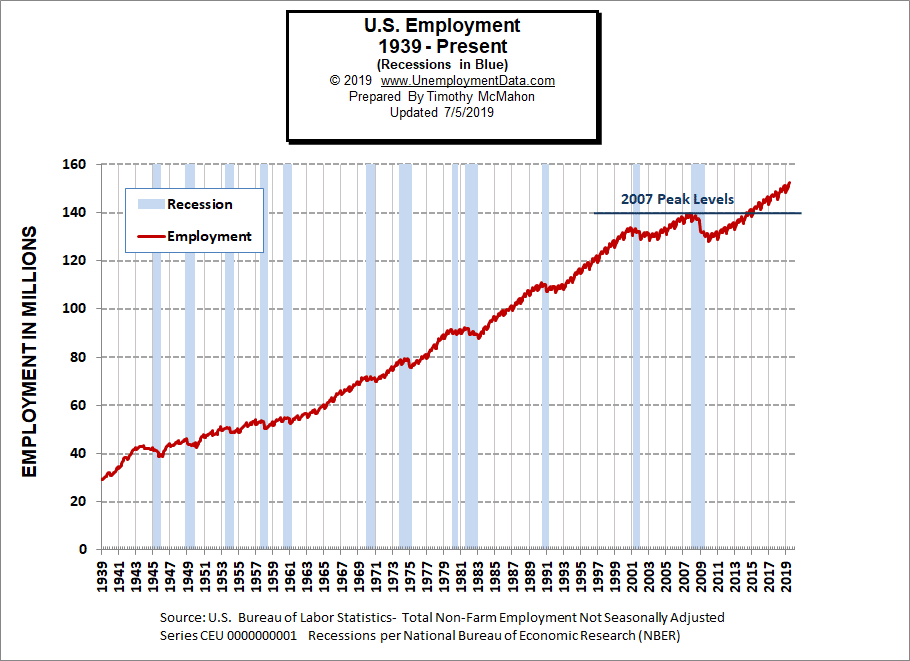
| Date | Employment in Millions |
| January 2007 | 135.335 |
| November 2007 (Peak) | 139.510 |
| January 2008 | 136.268 |
| January 2009 | 132.042 |
| January 2010 | 127.820 |
| January 2011 | 128.778 |
| January 2012 | 131.113 |
| January 2013 | 133.081 |
| January 2014 | 135.488 |
| January 2015 | 138.511 |
| January 2016 | 141.088 |
| January 2017 | 143.393 |
| January 2018 | 145.428 |
| January 2019 | 148.295 |
| February 2019 | 149.148 |
| March 2019 | 149.864 |
| April 2019 | 150.938 |
| May 2019 | 151.600 |
| June 2019 | 152.307 |
Employment Numbers are “Preliminary” for two months before the BLS considers them finalized due to late coming data.
See Historical Employment and Current Employment for more info.
Employment by Sector
The employment “bubble chart” gives us a good representation of how each sector of the economy is doing (employment wise). As we can see from the chart below there are two sectors to the left of the vertical zero line this month, meaning that they lost employees. The biggest loser is retail with a loss of -5,800 jobs. The other loser is Mining and Logging -1,000 jobs.
The biggest gainer (furthest to the right on the chart) was Education and Health Services adding 61,000 jobs unfortunately this is a fairly low paid sector, earning only $906.51 on average per week. Transportation and Warehousing added 23,900 and construction added 21,000 jobs.
Average weekly wages rose again. It was $955.29 in April and $957.35 in May and $959.76 in June.
(See the table below for average weekly earnings and other details.)
How to read this chart:
Bubbles location on the chart tell us two things:
- Change in Employment Levels over the most recent month.
- Average Weekly earnings.
- The further to the right the bubble the larger the increase in the number of jobs.
- The higher up on the chart the larger the average salary.
Bubble Size tells us:
- Total Employment for the sector.
- Larger bubbles mean more people are employed in that sector.
Employment and Average Weekly Earnings by Industry
June 2019, Seasonally Adjusted
| Industry | Monthly Increase | Average Weekly Earnings | Employment Level |
| Total Private Employment | 191,000 | $959.76 | 128,755,000 |
| Mining and Logging | -1,000 | $1,562.75 | 758,000 |
| Construction | 21,000 | $1,207.69 | 7,508,000 |
| Manufacturing | 17,000 | $1,125.36 | 12,854,000 |
| Wholesale trade | 100 | $1,226.16 | 5,936,900 |
| Retail trade | -5,800 | $600.80 | 15,733,900 |
| Transportation and Warehousing | 23,900 | $952.88 | 5,567,200 |
| Utilities | 1,400 | $1,795.03 | 554,700 |
| Information | 2,000 | $1,518.24 | 2,808,000 |
| Financial Activities | 2,000 | $1,352.85 | 8,655,000 |
| Professional and Business Services | 51,000 | $1,219.32 | 21,462,000 |
| Education and Health Services | 61,000 | $906.51 | 24,231,000 |
| Leisure and Hospitality | 8,000 | $428.90 | 16,713,000 |
| Other Services | 10,000 | $793.73 | 5,933,000 |
The Differential between U3 and U6
The differential between the unadjusted U3 and U6 (reached by subtracting U3 from U6) bottomed at 3.5% during late 2018 but then it spiked up culminating in a 4.4% differential in January. But in February it fell back to 3.6% where it remained in March and April. But fell to 3.3% in May indicating a tightening labor market.
See Current U-6 Unemployment Rate for more info.
U-6 Unemployment
Current U-6 Unadjusted Unemployment Rate for June rose to 7.5% from 6.7% in May and 6.9% in April.
It was 7.5% in March and 7.7% in February. January 2019 was 8.8% and it was 7.5% in December 2018.
See Unadjusted U-6 unemployment for more info.
Labor Force Participation Rate
The Labor Force Participation Rate (LFPR) for june was 62.9 up from May and April when it was 62.8% but down from March’s 63.0%, and down from it’s January and February peak at 63.2%.
See Labor Force Participation Rate for more information.
Employment Population Ratio
The index many people think of when they hear the term Labor Force Participation Rate might be better described by the Employment Population Ratio. This index shows the percentage of the entire population that is working. In many ways it is a better index than the LFPR or the Unemployment rate. Current levels are back in the range of where they were in 2009 even though the population has drastically increased.
Here are some articles you might enjoy in case you missed them:
Read more on UnemploymentData.com.
- Best Side Hustles of 2019
- 5 Best Resume Software Programs to Create the Perfect Resume
- Money Sources to Fund Your New Business Venture
- Boost Your Productivity While Working from Home
- How to Get a Good Job Fast When Unemployed
From InflationData.com
- Annual Inflation in May: Down
- How Does Inflation Affect Foreign Exchange Rates
- Oil Price Inflation Charts and Tables Updated
- Health Insurance Inflation Over the Last 10 Years
- Are Deflationary Forces Taking Hold Again?
- Gold as an Investment
- How Inflation and Interest Rates Relate
From Financial Trend Forecaster
- 4 Precious Metals to Consider
- The Future of Social Security Disability
- U.S. Develops New “Humanitarian” Missile That Doesn’t Kill People
- U.S.-China Trade War: Who will Win?
- Elliott Wave: Market Signaling Fed to Cut Rates Soon
- What Typically Happens When These Charts Flip?
- Are Rate Cuts a “Death Knell” for Stocks?
- Is War Good for Stocks?
- The Long-Term Message from the VIX
From OptioMoney.com
- 3 Benefits of Finding a Reliable Family Lawyer
- 4 Hidden Car Costs
- Buying and Selling Ranch Land: A Beginner’s Guide
- 4 Tips to Cover the Bills When Your Disability Keeps You Home
- Investments You’ll Thank Yourself for in Twenty Years
From Your Family Finances

